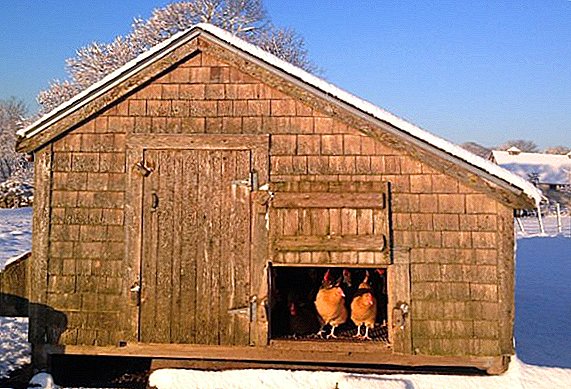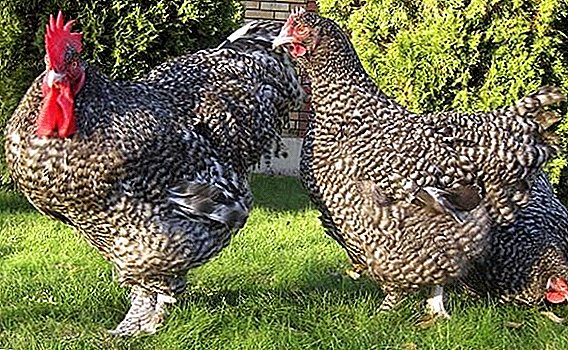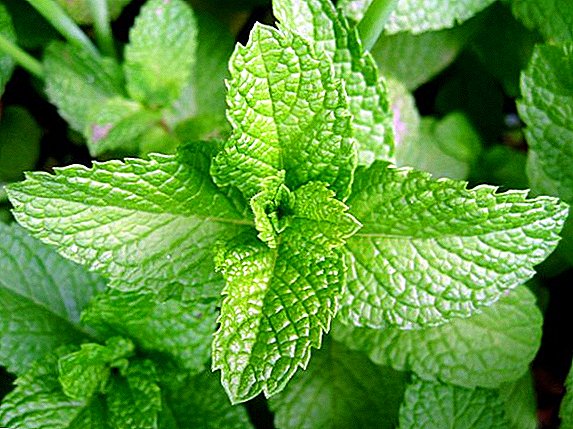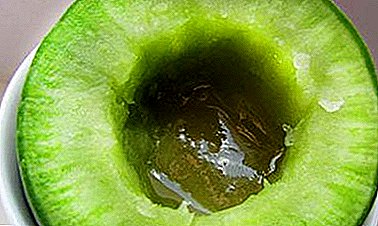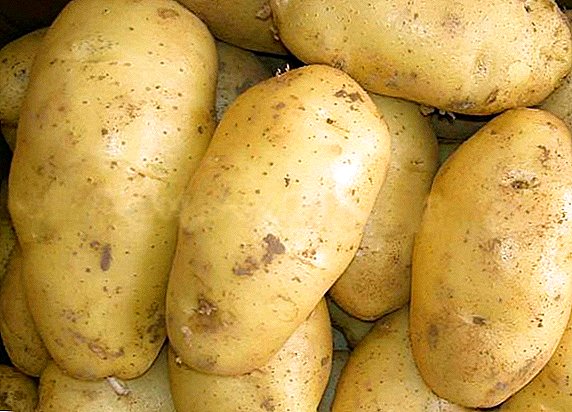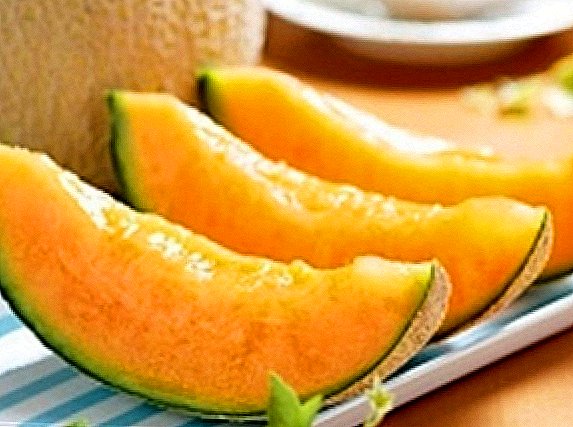
Melon is a representative of melon culture, a type of the Gherkin.
These pumpkins are valued for their great sweet taste, which even the most fastidious child who does not want to eat fruit will like.
In addition to sugar, melon pulp contains vitamins A, C and P, as well as ascorbic acid, salts of iron, sodium, potassium, and fiber.
Melon is valued for perfectly quenching thirst and refreshing the mouth.
In cooking, melon is combined even with meat, in particular, with entrecote, since seemingly incompatible products, when properly processed, create an excellent flavor combination.
What kind of varieties should be planted on the site? Just read the information below and you will find out.
Variety "Canaria"

Hybrid melon with super early ripening - 60-70 days. The bush is very similar to cucumber, that is, the shoots are represented by long vines.
The root system is developing well. Large fruitsweight reaches 1.5 - 3 kg. The shape of these melons is oval, the surface is smooth, not mesh, with a slight pubescence, of a beautiful yellow color.
The flesh of this variety is very fragrant, light green in color, with a wonderful sweet melon flavor with hints of honey. The thickness of the edible layer reaches 6 - 7 cm. There are a lot of ways to use "Canaria" variety melons.
Fruits can be eaten fresh, dried in candied fruits, cooked melon jam, jam and jam. In appearance, these melons are very good, and they also do not deteriorate during transportation, so they can be grown for commercial purposes. Hybrid "Canaria" has high immunity to anthracnose, fusarium and powdery mildew. The average yield is 2 kg per square meter. m
Variety "Canaria" is very susceptible to light and heat, therefore, recommend a greenhouse way of cultivation of this culture. Under the film can be grown in spreading, and in greenhouse conditions it is recommended to use the trellis method.
It is necessary to sow seeds for seedlings in the beginning-middle of May, so that the seedlings are strong enough before transplanting to the ground. Dripping seeds can be no deeper than 3-4 cm. In the process of growing seedlings, when planting time is near, you will need pinch the stalk over the fourth leaf.
Between the adjacent beds it is necessary to do intervals in 40 - 50 cm, between holes - 50-80 cm.
Melons "Canaria" need regular watering with warm water. But the degree of soil moisture must be kept under control in order to prevent overmoistening, which can lead to the appearance of root rot.
Also needed loosen the ground around the bushes, but it should be done very carefully so as not to catch the roots of the bushes. It is also necessary to pinch the shoots so that the fruits ripen faster and better. The fertilization procedure is very similar to the same process, but in the case of growing cucumbers.
Variety "Princess Anna"

Hybrid, and early. It is enough 60 - 70 days after germination to achieve the fruits of maturity. Bushes powerful, strong.
Melons of this variety are very beautiful in appearance, the skin is milky-white, smooth. Fruits form in the form of ovals, the weight reaches 1.4 - 2.2 kg.
Inside these melons are creamy orange, very juicy and dense. Honey taste. The use of Princess Anna melons is very diverse, that is, they are suitable for drying, fresh, and for preparing various kinds of products.
This kind of melon is characterized by high resistance to diseases, as well as adaptability to changing weather conditions.
Because of its unpretentiousness, the bushes of these melons will grow well in the open field, not only in the spread, but also on the trellis. Need to start with seedlings, sowing of seeds which is best produced in May.
The question of picks depends on how much capacity the roots have filled. Before planting it is necessary to pinch the tops of the shoots so that the seedlings have more strength to settle down in the ground. Landing layout standard 50x80 cm.
Care for melon bushes of this variety is normal. You just need to regularly water the plants, feed and cultivate the soil around them.
After the fruits have already appeared, it will be necessary to cut the tops of the shoots above the fifth or sixth leaf, leaving at the same time from 3 to 5 fruits on the bush. Then melons ripen faster and will be of high quality.
If you see that in about 10 to 15 days the fruits are already ripe, then you will need to stop watering the bushes so that the fruits are not watery.
Variety "Sweet Pineapple"

Early hybrid (65 - 70 days). Plants grow well, form quite strong roots. Fruits are oval-shaped, yellow-orange, weighing up to 2.5 kg.
The surface is rough, covered with a large mesh. The flesh of this variety is yellow-green, it smells like pineapple and tastes very sweet. This hybrid was immunized to anthracnose.
Also, bad weather conditions and temperature fluctuations are not afraid of the bushes of this melon. Due to its taste, this variety is suitable for commercial cultivation.
It is possible to sow the seeds at a time when the temperature of the earth has reached at least 15 ° C. The seedling of melons “loves” rather high temperatures, namely 25-30 ° C. Before planting, seedlings should be kept in peat pots for at least 25-30 days.
The landing pattern is normal. It is better to grow melons of this variety in greenhouse shelters, but only in the place where there is a lot of sunlight. Then the seedlings will take root faster, and the fruits will soon reach maturity.
These melons need a lot of light and water, so it is not advisable to subject plants to such tests as drought or hypothermia. If at night the temperature drops significantly, it is better cover the garden with plastic wrap.
Be sure to loosen the soil to oxygen flowed evenly to all the roots. You can also cover the ground with sawdust or straw to prevent weeds from growing.
Variety "Early Sweet"

Variety with medium ripening periods (71 - 80 days). Bushes are very similar in appearance to cucumber, flowers of both plants of the same yellow color.
The fruits are almost spherical, slightly oblong, weighing 2 - 3 kg. The peel is bright yellow, smooth to the touch, the grid is missing. The fleshy portion of creamy melons with a yellow tinge, melts in the mouth, sweet in taste, has a great aroma.
Neither powdery mildew nor anthracnose can hit the bushes of this variety. In addition to these advantages, the melon "Early Sweet" can withstand unstable weatheras well as very cold resistant.
Sowing seeds should be done approximately 26 - 33 days before transplanting into the ground. It is better to grow these melons in the greenhouse, but in the conditions of the southern climate, fruiting will be active even in unprotected land. Be sure to pinch the tops of the shoots on each seedling, so that the plant is not too actively released stepchildren. The landing scheme is ordinary.
For plants of this melon will be enough regular watering, pasynkovaniya and a few dressings. It is because of its simplicity that these plants are so easy to care for.
First, the water for irrigation should be warm, but when the daytime temperature is high enough, you can go to a cold one. Pass the bushes need after the appearance of the 6th leaf. Normal load on one plant will be 3 - 5 fruits. When feeding, it is important not to overdo it with nitrogen fertilizers, otherwise the fruits will not be very good.
Grade "Gold Scythians"

Early hybrid melon. Fruits can be consumed and used 75 to 80 days after seed germination.
Bushes are ordinary, do not differ from the plants of other varieties. Fruits are round oblong, weighing 1 - 1,5 kg, yellow color, with a large grid.
The flesh is yellow, very juicy, sweet, with a pleasant smell. Possesses powdery mildew resistance. These melons will be selling well thanks to their taste.
The beginning of April is the best time to prikopat seeds on the seedlings of this dina. After 30 - 35 days it will be possible to transplant seedlings into the ground, moreover, closed, since this variety is designed specifically for growing in a greenhouse.
Dripping seedlings need rarely, according to the scheme 70x150 cm.
Watering these plants should be moderate, so as not to have an excess of moisture in the ground. Especially carefully you need to water the bushes when the melons themselves ripen.
It is preferable to let the bushes along the trellis to make it easier to harvest and care for plants. When the length of the shoots will reach 50 cm, then you will need to remove all stepchildren. All other pruning procedures will need to be carried out at the level of the first - the third sheet.
Grade "Golden"

Medium early melon, 70 to 80 days pass from the moment the seedlings germinate before the fruits are sufficiently ripe.
The plants are strong, beautiful, with developed roots close to the surface. Fruits are rich yellow, oval, with stripes.
Weight ranges between 1.5 and 2 kg. The flesh is pale yellow, juicy, with nectar taste and melon flavor. These melons have not only great taste, but also high concentration of various vitamins.
These fruits can be easily processed into jams and jams, dried and also eaten fresh. This grade resistant to anthracnose and powdery mildew.
Seeds can be buried in containers for seedlings in mid-May. When it will be 25 - 30 days after they germinate, then it will be possible to replant the seedlings into the ground.
If the climate of the region is changeable, then it is better to allocate a place for these melons in the greenhouse. If the weather is good, then you can safely grow these plants in the open air.
It is important that the seedlings have a lot of light, and it should be distributed evenly. The landing pattern is normal.
Variety in fact unpretentious in the care, which facilitates the care of his plants. Therefore, you should water these melons in a timely manner, but a short-term drought will not hurt much. Top dressing is best done with irrigation to nutrients better passed into the ground.
After fertilization and irrigation, the soil needs to be loosened and mulched, otherwise weeds will develop around the beds. It is also necessary to conduct pinching and pinching shoots.
It is also interesting to read about the best varieties of strawberries.
Grade "Cinderella"

Early ripe hybrid variety, which requires only 60 - 70 days for the onset of technical maturity of the fruit. Bushes weave heavily, foliage average.
The leaves are large, green, cut slightly. Fruits are oval, yellow in color, despite the presence of a grid, the surface is smooth.
In weight reach 1 - 1.2 kg, but high yield varieties - 4 kg per sq.m. Cream-colored flesh, formed by a layer of 3 - 3.5 cm thick, crunches on the teeth, very sweet and fragrant.
Cinderella has highly resistant to diseases, as well as temperature changes. This variety is characterized by long preservation of appearance and taste for 15 - 20 days after the breakdown. Therefore, the transportability of the fruit is good.
Seedlings need to lay no earlier than the beginning of May, otherwise it will grow into pots. 25 - 30 day old seedlings can be dripped, and not only in closed ground. The open-air planting scheme is one, namely 140x100 cm, and in the greenhouse it is different - 70x70 cm.
When the third or fourth leaf has already formed on the seedling, it is possible to transplant the seedlings.
The variety itself very unpretentioustherefore, its care is very simple. That is, you need to constantly water the bushes with warm water, you can with the addition of fertilizers.
You also need to remove unnecessary stepchildren and cut the tops of the shoots of each bush. Rationing load on plants is required. As a preventive measure, bushes can be treated with antifungal drugs.
Growing a melon is no more difficult than growing a cucumber. So feel free to buy seeds, sow them for seedlings, transplant seedlings to the site and wait for the appearance of yellow sweet fruits.


